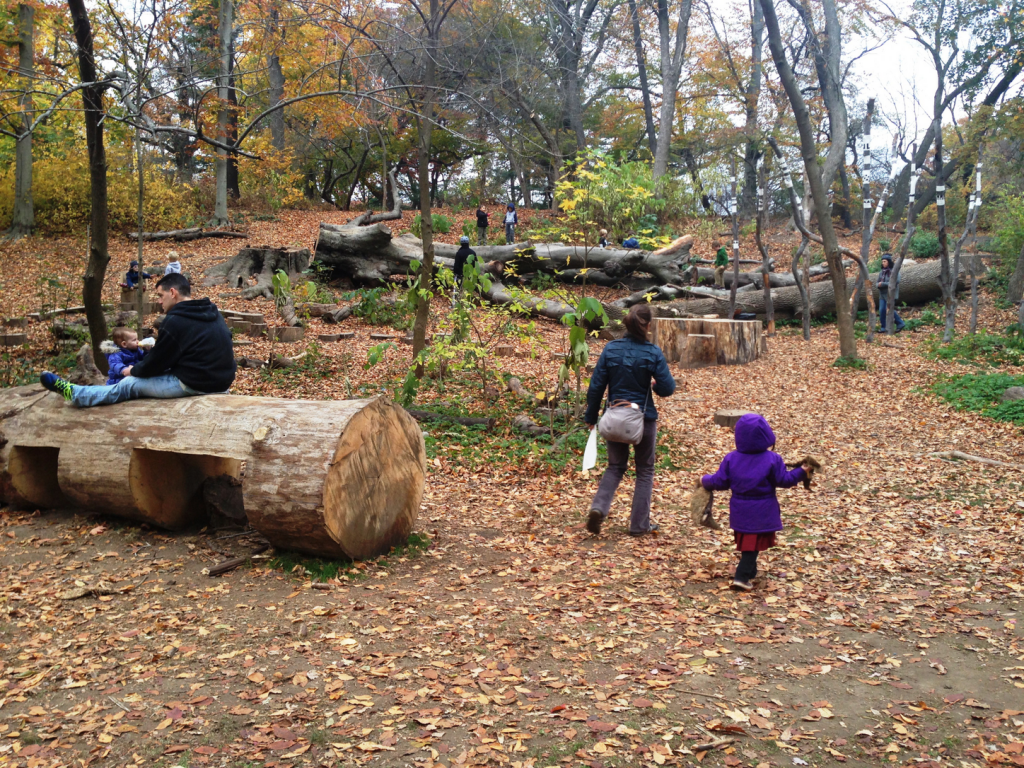
So when I visited the new ‘Natural Exploration’ Area at Prospect Park in Brooklyn I kept thinking about my first posts on this idea of a ‘natural playground’. It was 2008 and I’d only just come across the term, and to be honest, I wasn’t too keen. I’d started the blog because it seemed like so many playgrounds were poorly designed and not much fun, but the play space in that old post–pretty much just a log lying in a bed of sand–also didn’t seem well designed or much fun. As the natural playground concept began to grow dramatically over the next few years, conversations with friends in the industry confirmed that that the fad for the natural was leading to makers who would drop a few rocks like pellets or add some logs for edging and call it natural; just one more box to check in their list of kit.
But as the idea has matured, we’ve come to see some really great examples of natural playscape design, and the Prospect Park Natural Exploration area embodies many of the potentials and delights of this type of playground. Here’s why it’s great, and why it’s different from that ‘natural playground’ I posted five years ago.
1. Undefined boundaries. Except for the sandpit, which obviously needs some confinement, the elements of the playscape simply diffuse out into the surrounding, lightly tended woods. A child feels that they are ‘discovering’ a landscape, not ‘visiting’ a playground. Just how attractive this was to the kids was revealed by the fact that there are two similar sets of wood features in this installation; one in an open sunny space, and one tucked in the trees. 80% of the play was in the trees. And it was a chilly day.
2. Creative use of topography. When will we stop looking for (or worse, making!) the flattest place in the park and putting the playground there? Arrgh! At Prospect Park the sand pit occupies the front of the space next the paved path, where the ground is flat and it can draw the children in by signifying to both they and their parents ‘this is a playground’. But the best features are placed on an inclined bank down a wide clearing. Not only does the incline make the space ‘feel-risky-play-safe’, it’s also more challenging physically. One of the criticisms of natural playgrounds is that there is no provision for upper body development. But put an enormous felled tree on an incline and the upper body work the kids will do to clamber over it is just as good as the monkey bars any day.
3. Really interesting loose parts. Happily there’s plenty of that playground essential, sand. But the Prospect Park Alliance went for more than just the ubiquitous tree cookies in their loose parts. A y-shaped log with some fabric ties for handles was being happily dragged through the sand the whole time I was there. It was a good substantial size, challenging for a bigger kid, but also enticing smaller kids to work in pairs or groups in order to manipulate it. The prismatic angles on the wooden blocks scattered around for seating made for a nice hard-edged contrast to all the organic forms, but they were also rollable, though with difficulty, requiring lots of upper body work from the 9-year old turning one through the sandpit. There were also bits of turf mats left around. The younger kids in particular LOVED these, and kept picking them up and waving them around (look for the little girl in the purple coat) Loose parts that decompose when carried off and dropped elsewhere in the park…great concept! But the most interesting thing was how the extensive use of wood in the playscape seemed to encourage the kids to create their own wooden playpieces. Everywhere I looked they were picking up treefalls–from twigs up to small limbs–and using them for their own imaginative games.
4. Thoughtful use and placement of the timbers. Not just in the woods and up the slope, but growing out of the sandpit like dinosaur bones, with nice flat surfaces for chalk drawings. Circling the playscape as a woodland ‘track’ of log steps that kept two little girls going round for an hour: through the wood, up the hill, past the fire circle (no fire but you could feel it) and back down to the open glade. Den spaces cut into one of the largest tree trunks. Providing places to sit, on carefully sited logs where parents are close but not too close. The big felled beech (the features were formed from Hurricane Sandy’s destruction) turned so that its old arborglyphs were visible like secret writings from long-ago. And clumps of slender upright branches with primitive markings gently defining the woodland/Neverland.
Very not-your-typical-New-York-playground. And brilliant. Take your kids, and tell the Prospect Park Alliance how much you love it! New York could use some more of these playscapes.
The post Donald and Barbara Zucker Natural Exploration Area, Prospect Park Alliance, Brooklyn New York, 2013 appeared first on Playscapes.